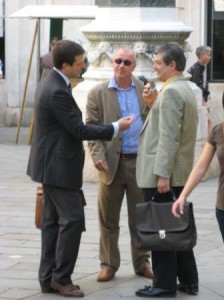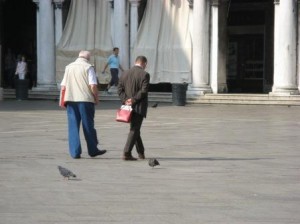One of the great things about learning the language of your location — or in my case, two languages, Italian and Venetian — is not that you will finally be able to explain to a local what the difference is between metaphysics and epistemology. Useful and entertaining though that might be.

No, it’s to catch so many fleeting remarks that you hear people making in all kinds of unexpected or unlikely places. Quips, execrations, assorted badinage, comments that are like little flakes falling from the facade of what we regard as normality.
Yesterday morning I was in the church of S. Francesco di Paola in via Garibaldi. There were eight people there for the 9:00 mass; the usual smattering of nuns from the nearby convent, and a couple of other women, and a man or two. One of the men is someone who seems always to come to this service.
He is old but not ancient; neglected but not repellent; in his own little world, but not actually crazy. His hair is ragged and he always sits by himself, and he is always the first in line to take communion. In fact, he’s first before there is a line. This is obviously his self-appointed right and privilege. He makes sure he’s already in position before the priest has even finished the prayer of consecration.
As the faithful were leaving in peace, obeying the canonical and very precise command at the end of every mass, I noticed one nun pausing in front of a new statue of Saint Anthony of Padua. It was about her height, actually, or maybe slightly shorter, and he was holding the Christ Child in the crook of his left arm and a lily in his right hand, as always.
So she’s standing there looking at it, maybe wondering where it came from or why it’s there now, or whether it needs dusting, or maybe just thinking about the saint. Or not thinking at all.
Seeing her, the old guy abruptly changes course and walks toward her.
“It doesn’t look anything like him,” he announces. “St. Anthony had a very sharp, aquiline nose.” He sounds as certain as if he’d been his brother. The nun just looks at him.
“He didn’t look like this– he had a very aquiline nose,” he repeated.
She said nothing. He paused, then wandered off and that was that. I too walked away, but fighting the urge to stop him and say, “You actually knew him? Wow….”
What he said may have been completely true, though I’m not sure we can trust most of the depictions of St. Anthony, even those made in his own lifetime before he was even close to becoming a saint.
But let’s say it’s true. Let’s say the statue doesn’t look anything like St. Anthony. So what? Devotional images aren’t supposed to help the police identify you, like photos on driver’s licenses. Is some man with a tonsure and a habit (not to mention carrying a lily and the Baby Jesus) likely to be walking around via Garibaldi claiming to be Saint Anthony?
Answer: Not likely. At least in this neighborhood; saints are pretty thin on the ground. Though he might be mistaken for a relatively harmless tourist, or somebody left over from Carnival.
But now we know — or think we know — that Saint Anthony had a very aquiline nose. I’ll be on the lookout.

Then there was the family waiting for a relative or maybe just a friend at the vaporetto stop at the Giardini, all set for some outing. The ladies were past middle age but full of energy, their hair ferociously sprayed, and their men were hanging around the periphery while the women batted little comments back and forth.
As I walked toward the dock, I heard one woman say firmly to the others, “She looks just exactly like the Queen of England. All she’s missing is the tiara. Wait and see.” This was a statement, not an opinion.
“There she is — finally! Helloooo,” the woman spotted the lady, then turned back to her friends. “You see? Look at her hair. Even the way she walks. She could be the Queen of England, am I right?”
Naturally I looked. But I have to say that it was a bit of a stretch. If we start referring to every late middle-aged, short, heavily upholstered woman with neatly curled short white hair, whose skirt falls just below her knee, as the Queen of England, we’re going to be spending all day curtsying.
And there was the other morning, as I left the house early and there was almost nobody on the street yet. The sun was just getting itself up and out the door, the air was cool, the world looked ready for business.
As I crossed the bridge to the fondamenta on the other side, “Cartolina” was walking by from his home way over in the Quintavalle neighborhood toward via Garibaldi.
“Cartolina” means “postcard” (somebody surely knows his real name, but that’s the only way Lino knows him and can’t tell me why he got this nickname) is a small, chunky, old man who is just a bubble off plumb but still full of energy, some of which he expends on what I call his little litany as he walks along, a sotto voce recital of how bad he feels and how old he is, directed at nobody in particular. It’s a pretty limited repertoire, usually assorted murmurings to himself and anybody in earshot: “Aiuto. Aiutami mamma. Aiuto. Povero vecio. Aiuto.” (Help. Help me mama. Help. Poor old guy. Help.)

I would never belittle his pain, which might be serious, for all I know. Lino told me that he used to work as a porter at the Bacino Orseolo near the Piazza San Marco, on call from any nearby hotel or office which needed somebody to shlep luggage or anything else heavy and cumbersome by means of an equally heavy handtruck, undoubtedly over many bridges. Years of that will mark you, but not many people orchestrate their own chorus of sympathy and then sing it themselves.
So the other morning he passes me on the bridge and I hear this: “Aiuto. Aiuto. Go 120 anni. No, 106. Go sbaglia’.” (Help. Help. I’m 120 years old. No, 106. I made a mistake.).
Then there was the morning (he seems to be a matutinal creature — I don’t believe I’ve ever seen him after 11:00 AM) we were having the first real fog of the fall. He was coming out of the bread bakery with a small sack, muttering: “Aiuto. Mamma mia. Ancuo magno pan e caligo.” (Help. Mamma mia. Today I’m eating bread and fog.)
This morning, I saw him coming as I was heading toward the Quintavalle bridge. He began in the classic way: “Mamma mia. Aiuto. Aiuto.” Then he said, “Vogio ‘na bela casseta. Vado via. So stufo.” (Mamma mia. Help. Help. I want a really beautiful casket. I’m out of here. I’m fed up.)
I love this guy! Not only can he make a joke about how bad he feels, he’ll make it to himself. Or to however many personalities are living in there.
